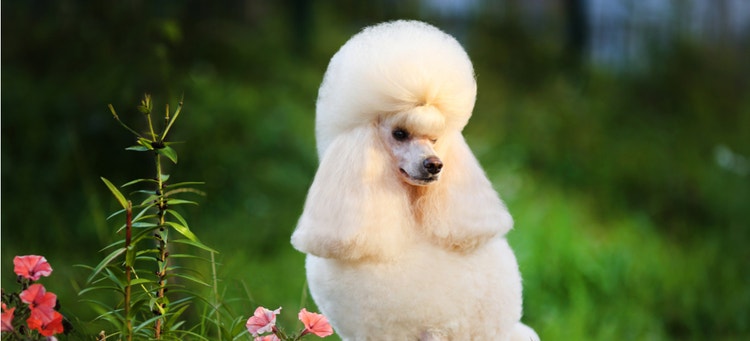
Poodle


Where Are Poodles From?
The Poodle originated in Germany, where they were used for duck retrieval.
This pampered breed was depicted in paintings by Goya, admired by Queen Anne of England, and favored by Louis XVI of France. The smaller varieties of the breed were used in England, Spain, and Germany as truffle hunters, since their small paws wouldn’t damage this delicacy while digging. Possible ancestors of the Poodle include the Maltese and the Spaniel.
It is believed that the Poodle was brought to France by German troops. The French were enchanted by the breed’s striking appearance and dignity, and their intelligence and trainability made them ideal performers in circuses across Europe.
They have been pampered in France for hundreds of years and, since many of their modern day traits were developed by the French, they have been officially recognized by the Fédération Cynologique Internationale as the breed’s nation of origin.
The Poodle has been acknowledged by the American Kennel Club since the late 1800s.
Caring for a Poodle
What Kind of Diet Does a Poodle Need?
What Kind of Diet Does a Poodle Need?
Diet for a Poodle depends on specific type (Standard, Miniature, or Toy) and age. As with all dog breeds, calorie intake needs to be monitored to ensure a healthy weight.
How Much Grooming Does a Poodle Need?
How Much Grooming Does a Poodle Need?
Daily brushing and professional grooming are recommended for Poodles, since these measures will prevent hair from matting or cording. Mats can become painful and may need to be removed.
Routine bathing and nail trimming are also recommended.
Are Poodles Healthy Dogs?
Are Poodles Healthy Dogs?
Poodles are predisposed to a variety of illnesses, some of which are dependent on size.
Standard Poodles are prone to gastric dilatation volvulus due to their deep-chested build. Smaller varieties of Poodle commonly experience medial patellar luxation (displacement of the knee cap), aseptic necrosis of the femoral head (deterioration of the femoral head), and tracheal collapse (weakening of the tracheal rings, which leads to coughing).
Smaller Poodles are also commonly linked to neurological diseases like epilepsy (seizure disorder), hydrocephalus (excessive cerebrospinal fluid in the brain), and granulomatous meningoencephalomyelitis (inflammation of the central nervous system), as well as hypoglycemia and a variety of cardiac diseases.
The life span of the Poodle breed varies from 14 to 16 years (Standard) to 15 to 18 years (Toy and Miniature).
Poodles are predisposed to: gastric dilatation volvulus, sebaceous adenitis, hip dysplasia, progressive retinal degeneration, epilepsy, hypothyroidism, diabetes mellitus, von Willebrand’s disease, cataracts, hyperadrenocorticism, glaucoma, intervertebral disk disease, degenerative myelopathy, insulinoma, hair loss, ear infections, bladder stones, allergies, cryptorchidism, deafness, dilated cardiomyopathy (Miniature/Toy), anal sac disease (Miniature/Toy), medial patellar luxation (Miniature/Toy), tracheal collapse (Miniature/Toy), aseptic necrosis of the femoral head (Miniature/Toy), patent ductus arteriosus (Miniature/Toy), chronic valvular disease (Miniature/Toy), hemorrhagic gastroenteritis (Miniature/Toy), immune-mediated hemolytic anemia (Miniature/Toy), hypoglycemia (Miniature/Toy), granulomatous meningoencephalomyelitis (Miniature/Toy), ectopic ureters (Miniature/Toy), and hydrocephalus (Toy).
How Much Training Does a Poodle Need?
How Much Training Does a Poodle Need?
Training a Poodle is easy, since they are smart, friendly, and eager to please. The breed responds well to training related to tricks, games, agility, and hunting.
Keeping them occupied with family activity and frequent exercise will help prevent destructive behavior.
How Much Exercise Does a Poodle Need?
How Much Exercise Does a Poodle Need?
Poodles require daily exercise. They enjoy retrieving games, swimming, and mastering tricks, so these should be incorporated into their exercise regimen as often as possible.
What Are the Physical Characteristics of a Poodle?
Poodles have monochromatic coats, which come in colors like black, white, gray, blue, brown, café au lait, apricot, and cream.
The texture of their hair coat is dense with tight curls.
Poodle Facts
Other Breeds to Explore
References
- Morris, Desmond. Dogs: The Ultimate Dictionary of Over 1,000 Dog Breeds. Trafalgar Square, 2002.
- American Kennel Club. The Complete Dog Book. Random House Digital, Inc., 2006.
- Wilcox, Bonnie and Chris Walkowicz. The Atlas of Dog Breeds of the World. T.F.H Publications, Inc., 1995.
- Poodle Dog Breed Information. American Kennel Club, 2021.
- Bygone Performing Poodles. Poodle History, 2021.


